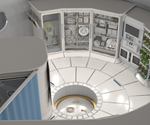Basalt fiber composite design wins NASA 3D Printed Habitat Challenge
New York-based AI SpaceFactory’s MARSHA prototype uses automation and composites to create a stronger, more durable space habitat.
AI SpaceFactory (New York, N.Y., U.S.) was recently announced as the first place winner of NASA’s 3D Printed Habitat Challenge, for its construction of MARSHA, a 3D-printed basalt fiber composite structure intended for Mars habitation.
The 15-foot-tall prototype, 3D-printed during the final phase of the competition, is constructed from a biopolymer basalt fiber composite, said to biodegradable, recyclable and derived from natural materials that are also found on the surface of Mars. The material passed NASA’s pressure, smoke and impact testing, and was found to be stronger and more durable than the concrete used by some of the 60 other competitors in the challenge. The habitat was printed in 30 hours in a largely automated process, and the three windows in the structure were also robotically placed. AI SpaceFactory was awarded $500,000 by NASA for this competition.
AI SpaceFactory spent two years developing these construction technologies for Mars, and it has plans to recycle the materials from MARSHA to 3D-print TERA, a space-tech eco habitat for use on Earth said to be the first of its kind.
"We developed these technologies for space, but they have the potential to transform the way we build on Earth,” says David Malott, CEO and founder of AI SpaceFactory. “By using natural, biodegradable materials grown from crops, we could eliminate the building industry’s massive waste of unrecyclable concrete and restore our planet.”
TERA is expected to launch on Indiegogo this month and will be available to anyone wanting to experience what sustainable life might be like on Mars. The intent, the company says, is to emphasize the need for new, renewable construction technologies on this planet, while researching what’s needed to enable life on a new one.
Video: Three important lessons for 3D printing large parts are discussed in this video about a lunar habitat made of glass-fiber-filled ABS.
Related Content
-
The next evolution in AFP
Automated fiber placement develops into more compact, flexible, modular and digitized systems with multi-material and process capabilities.
-
3D-printed CFRP tools for serial production of composite landing flaps
GKN Aerospace Munich and CEAD develop printed tooling with short and continuous fiber that reduces cost and increases sustainability for composites production.
-
Optimizing a thermoplastic composite helicopter door hinge
9T Labs used Additive Fusion Technology to iterate CFRTP designs, fully exploit continuous fiber printing and outperform stainless steel and black metal designs in failure load and weight.

.jpg;width=70;height=70;mode=crop)














